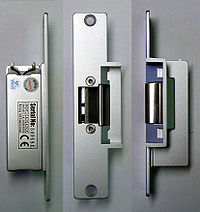
Electric strike
Encyclopedia

Access control
Access control refers to exerting control over who can interact with a resource. Often but not always, this involves an authority, who does the controlling. The resource can be a given building, group of buildings, or computer-based information system...
device used for door
Door
A door is a movable structure used to open and close off an entrance, typically consisting of a panel that swings on hinges or that slides or rotates inside of a space....
s. It replaces the fixed strike faceplate
Strike plate
A strike plate is a metal plate affixed to a door jamb with a hole or holes for the bolt of the door. When the door is closed, the bolt extends into the hole in the strike plate and holds the door closed...
often used with a latchbar (also known as a keeper). Like a fixed strike, it normally presents a ramped surface to the locking latch allowing the door to close and latch just like a fixed strike would. However, an electric strike's ramped surface can, upon command, pivot out of the way of the latch allowing the door to be pushed open (from the outside) without the latch being retracted (that is, without any operation of the knob) or while excited the knob or lever can be turned to allow egress from the secured area.
Electric strikes generally come in two basic configurations:
- Fail-secure. Also called fail-locked or non-fail safe. In this configuration, applying electric current to the strike will cause it to open. In this configuration, the strike would remain locked in a power failure, but typically the knob can still be used to open the door from the inside for egress from the secure side. These units can be powered by AC which will cause the unit to "buzz", or DC power which will offer silent operation, except for a "click" while the unit releases.
- Fail-safeFail-safeA fail-safe or fail-secure device is one that, in the event of failure, responds in a way that will cause no harm, or at least a minimum of harm, to other devices or danger to personnel....
. Also called fail-open. In this configuration, applying electric current to the strike will cause it to lock. In this configuration, it operates the same as a magnetic lock would. If there is a power failure, the door would open merely by being pushed/pulled open. Fail safe units are always run using DC power.
Electric strikes are sometimes equipped with buzzers which allow someone outside the door to hear when the door is open. The buzzing noise is typically simply a result of applying AC
Alternating current
In alternating current the movement of electric charge periodically reverses direction. In direct current , the flow of electric charge is only in one direction....
current to the strike instead of DC
Direct current
Direct current is the unidirectional flow of electric charge. Direct current is produced by such sources as batteries, thermocouples, solar cells, and commutator-type electric machines of the dynamo type. Direct current may flow in a conductor such as a wire, but can also flow through...
, keep in mind the "buzzing" varies depending on voltage, and the coil or solenoid, although the buzzing from the AC current is audible, it is not designed to be loud for everyone to 'hear'. Using DC voltage, one would have to install an actual buzzer if they would want to "hear" the unit.
There are many manufacturers of strikes, and there are many things that have to be considered when buying one, i.e. type of jamb, type of locking hardware, whether one requires fail secure or fail safe, length of latch, depth of jamb, voltage requirements and the length of the faceplate. In some cases it is better to go with a magnetic lock
Before using a magnetic lock, the Fire Marshal or appropriate “Authority Having Jurisdiction” should be consulted. There are emergency egress issues that must be addressed before using a magnetic lock.

